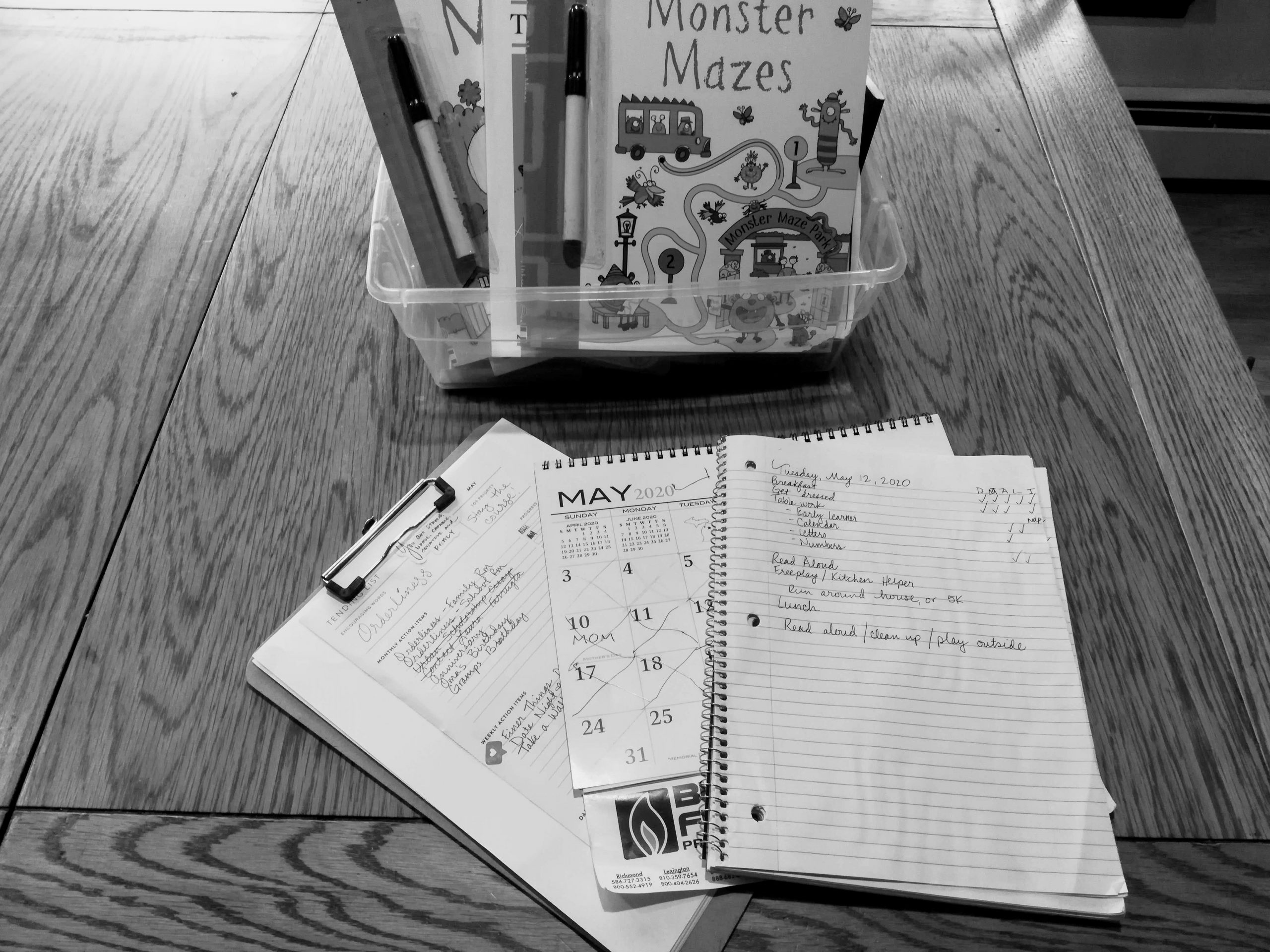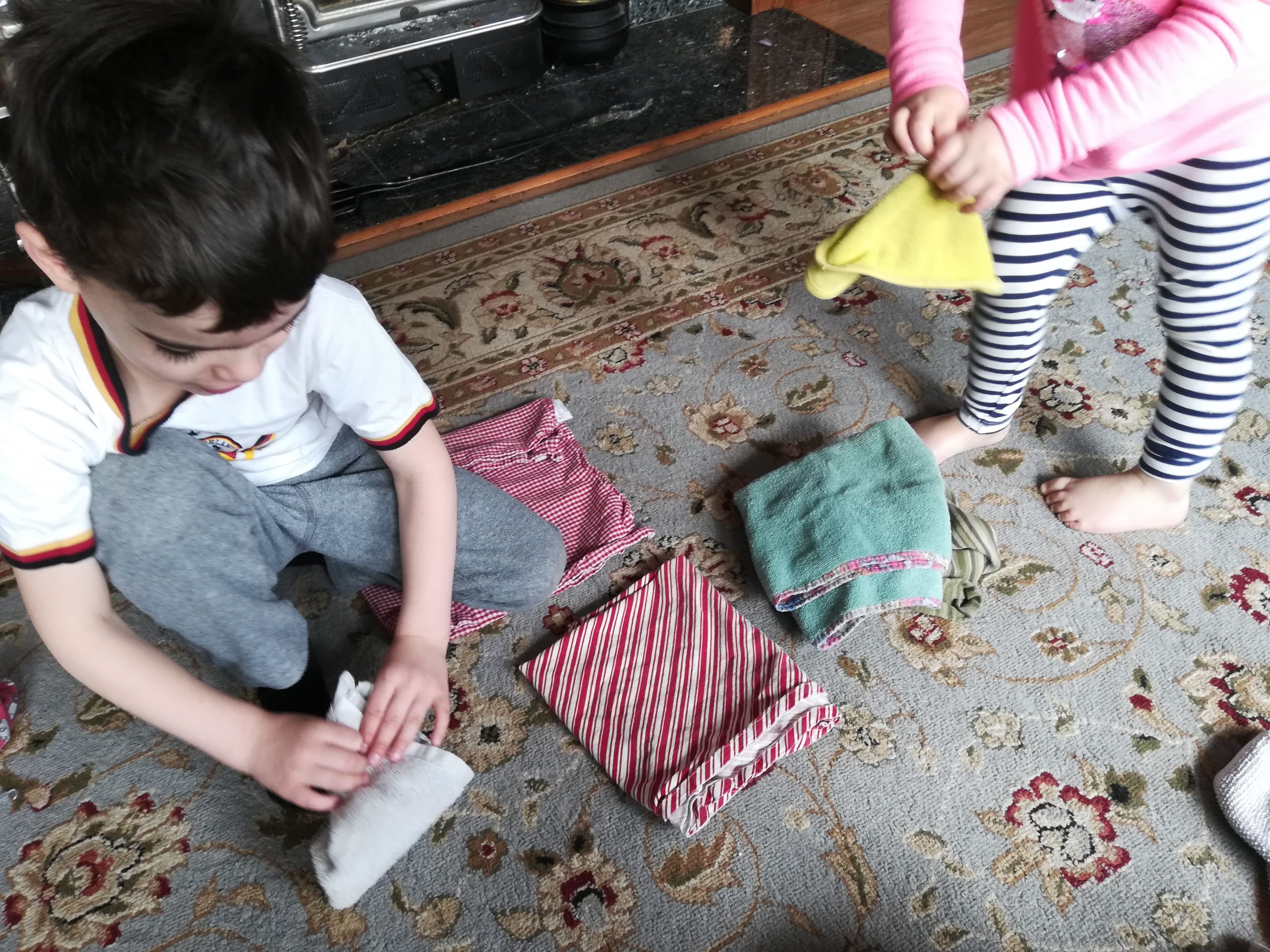Rhythm, routine, schedule…whatever you call it, we all need some kind of structure to our day when home with kids. Using a block schedule at home with kids is a great way to outline a regular plan for each day that still allows freedom. Breaking the day into two- to three-hour chunks helps us to stay flexible within each block while providing daily structure. Set a morning wake up time, and then choose meal times (include snacks!), outside time, and down time. Our typical schedule looks a little something like this:
6-9 a.m. | Good morning!
We have early risers in our home. My kids play freely before breakfast. I use strategic screen time here. Letting my kids watch a show while I have some personal time to shower, drink a cup of coffee, and wrap my mind around my day makes everyone happier. My preschooler’s favorite shows right now are Treehouse Detectives (Netflix), Word World (PBSKids) and Tumble Leaf (Amazon Prime).
Include your kids in maintaining your home. My kids help empty the dishwasher before breakfast. I invite one of them to be my special kitchen helper and prepare breakfast. After they eat, they are responsible for placing their dishes in the sink and sweeping/vacuuming under the table. We get dressed, make beds, and brush teeth after breakfast. Figure out a reasonable chore list for your kids and hold them accountable to it.
Bonus: overwhelmed by the idea of creating a schedule? Click here for 30 printable visual schedule cards.
9-11 a.m. | Time for School!

Our first schedule block is table work: math and writing. I try to switch things up every 15-20 minutes so we don’t get burnt out. Use timers to keep things moving. I rotate different motor skills– fine motor table work followed by a gross motor game, then move to the couch to read aloud, then back to the kitchen to do a simple science experiment. I also intersperse “wise choice time” where my kids can choose an activity to do independently. For my littles, this could be lego, magnatiles, puzzles, etc. Rotating through stations keeps things interesting.
Think outside the box for creative ideas. Cooking and sewing both use a lot of math skills. Most games involve logic, strategy, and other math skills. For writing, keep a journal for the week. Invent a character and write a short story. Have your kids tell a story about when they were little. Watch a documentary and start a debate. Find a nature webcam and learn about animals. Brainstorm with your kids and come up with a list of things you want to know more about or questions you want to answer. Most of all, have fun. Open your eyes to all of the learning opportunities around you!
Bonus: Brave Writer is offering 100 daily free writing prompts for free right now!
11-1 p.m. | Lunch Time
Instead of an exact time for lunch, a block of time in my schedule allows flexibility. If we’re in the middle of something and having a great morning, lunch can be pushed back. My kids help make lunch. Even toddlers can scoop yogurt or cottage cheese into bowls and rinse berries. Preschoolers can spread peanut butter and use kid-safe knives to help make salad. Older kids can take even more responsibility. Whenever possible, we like to take lunch outside. Why not mix things up and spread a blanket on the floor for an indoor picnic? Surprise your kids. After lunch, turn up the music and do a quick clean up!
Bonus: 30 Easy Recipes Your Kids Can Make Themselves.
1-3 p.m. | Quiet Time Block
Kids of all ages benefit from some down time. In our family, our quiet time block starts out together by piling up on the couch with a chapter book. Looking for a good book? Check out the Read Aloud Revival. Every month they publish reading lists, or you can search her website for lists by subject. My favorites are the Picture Book Biographies and the Math Booklists! She even has a quiz you can take to point you to a personalized read-aloud book recommendation. After we finish a chapter in our family read aloud, each kid takes a stack of picture books (We love Usborne flap books) to their rooms. As an alternative, my kids love listening to audiobooks and doing a quiet activity. Puzzles, lego, coloring, or even watching a documentary are all good quiet time activities.
Bonus: looking to spice up your reading time? Click here for 25 activities for reading and writing fun.
3-5 p.m. | Afternoon Fun
Our afternoons are for fun. We try to get outside for at least a short time no matter the weather. Sunlight boosts your immune system (and your mood), fresh air clears the head, and outside play is great for kids’ development. Go for a walk, head to the park, or just lay a blanket on the ground and take the tablet outside.
Hungry kids? It’s time for tea. At least once a week, I try to have a poetry tea time. I cut the PB&J into tiny bites, put them on a fancy platter with some grapes, pour some juice, and call it tea. My kids love doing something special. We use our fancy manners, practice taking turns, and I read a poem or two from a kid’s poetry book. You can do as much or as little with this as you like, but I promise you, your kids will love the extra pizzazz.
Other ideas for afternoon fun are kitchen science experiments, learn a new skill like knitting or crocheting, play a board game, do a memory obstacle course, or break out your art supplies and watch a youtube tutorial for watercoloring or brush lettering. We have this kids table with bins from IKEA in the corner of our kitchen for play-doh, sensory activities, and other messy activities. I’ve also started collecting boxes, plastic containers, cardboard, plastic lids, and anything that looks interesting and saving it for our Make Stuff Station. The kids love it!
Bonus: 110 Fun Activities at Home for Kids.
5-9 p.m. | Dinner & Bedtime Routine
Cooking and eating brings the family together. Invite one of your kids to make dinner with you. Create a menu, find some recipes, and set up a pretend restaurant. Teach your kids how to make a family favorite recipe. Inventory your kitchen and let your kids create a menu for the week. Busy hands are great for conversation, so take the time to talk while you chop the veggies.
After dinner (and a dance party clean up!), it’s family time. Work on a puzzle together. Play a game. Or, teach how to organize a closet, deep clean a bathroom, or mop the kitchen floor. We like having family movie nights, and making a list of classic films to watch together as a family is a great way to get everyone on the same page. You could even do theme nights, where you tie together dinner and a movie, such as eating tacos and watching Coco together.
Finish out the night with a bedtime routine. Include another chapter from the family read aloud, and individual pillow talk. I like to ask my kids what they liked best about their day, as well as asking if anything made them feel sad or mad. After the kids are in bed, take a moment to reflect on your day and write a to-do list for tomorrow, do something that brings you joy, and connect with your partner.
Bonus: Check out this great list of 50 Questions to ask your kids for some bedtime inspiration.
Using a block schedule with kids at home is a wonderful way to provide structure while still maintaining flexibility and leaving enough room for spontaneity. It’s pretty simple to put into action, too. Give it a try!












